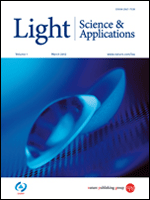Recent News
CHTM Joins NSF's NQVL Pilot Projects
August 9, 2024
OSE PHD, Dr. Xuefeng Li - Wins The Outstanding Interdisciplinary Graduate Programs Award
May 10, 2024
Dr. Ali Rastegari - 2024 OSE Best Dissertation Award Winner
May 10, 2024
2024 OSE Spring and Summer Graduates
May 10, 2024
News Archives
A world first: Researchers open up new avenue in field of photonics
March 1, 2016 - Sharon Steely

Frédéric Grillot
UNM ECE
Research Professor;
CHTM faculty member;
Télécom ParisTech
Associate Professor
Professor Frédéric Grillot, Research Professor with UNM's Electrical and Computer Engineering Department and a member of CHTM faculty, has collaborated with a research group who performed the very first observation of chaos in mid-infrared optical radiation. The research was conducted in Paris, France. Along with Professor Grillot in his capacity as Associate Professor at Télécom ParisTech, the research collaborators included: Louise Jumpertz (Télécom ParisTech), Dr. Kevin Schires (Télécom ParisTech), Dr. Mathieu Carras (mirSense) and Professor Marc Sciamanna (CentraleSupélec).
The result of their research makes a significant breakthrough for the photonic community working in these wavelengths. Major industrial applications are expected in the field of optical communications and sensing. Their discovery was accepted for publication in the journal Light: Science & Applications, classified as the second-highest-impact journal in optics, published by the Nature Publishing Group. Read the preview of the paper to be published, "Chaotic LIght at Mid-Infrared Wavelength" (PDF).
Discovery in context
Semi-conductor lasers were invented in 1962 and are vital to modern daily life. For example, they generate the optical impulses that carry ever-greater amounts of information in fiber-optic networks over great distances.
Due to a mature technology, quantum cascade lasers (QCLs) may operate under continuous wave mode, at room temperature, in single- or multi- mode operation and with high output powers — up to a few watts from mid-IR devices.
In their work, Professor Grillot et al. show the very first observation of nonlinear dynamics and the underlying sequence of bifurcations to chaos in a QCL, providing the first-ever source of deterministic temporal chaos at mid-infrared wavelength. Their research contradicts 35 years of knowledge of laser diode destabilization, by demonstrating a sequence of bifurcations to chaos that involve self-pulsation at the external cavity frequency, so far only observed in gas lasers.
The reinjection of only a small part of the emitted energy back into the laser was sufficient to destabilize the quantum cascade laser to chaos. The laser emission is then formed of chaotic pulses, which are irregular in time and unpredictable.
“This work would not have been possible without the high degree of maturity of the quantum engineering technology developed at mirSense,” said Dr. Grillot.
Key industrial applications
Permanent use of laser sources in the mid-infrared field (MIR), or the use of chaotic optical transmission, in free-space communications is now possible. This will facilitate the security of data transmitted directly and the development of non-predictable sources for optical countermeasures. It is a paradigm shift in the understanding of light sources operating at these wavelengths.
The mid-infrared domain (MIR) combined with the transparent atmospheric window (3-μm and 10-μm) is potentially involved in a very large number of applications:
- Direct optical communications
- Gas analysis
- Air pollution control
- Monitoring of industrial processes
- Medicine
- Assistance in diagnosis
- Reconstructive surgery
- Military
- Laser radar
- Countermeasures
The results presented in the group's paper, "Chaotic LIght at Mid-infrared Wavelength," are important for future applications of semiconductor QC lasers operating in the MIR domain.
Summary of research written by Professor Grillot (PDF)
Faculty website; also listed at CHTM



